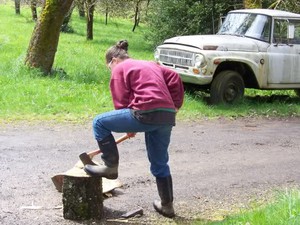The Correct Way to Cut Firewood

I know it sounds terrible, but one of the reasons that I like working with firewood is that people leave me alone. I’m not asked to vacuum the living room, fix something or give anybody a ride. Maybe it’s because people don’t want to learn how to cut wood properly and get too close to a guy running a chain saw, or perhaps they know that I’m liable to put them to work stacking wood or dragging logs, among other things.
In the very first place, you need a decent woodworking bench plans. There’s no reason in trying to hang out with or pester a guy who’s working up a sweat. And make no mistake, cutting, splitting and stacking firewood is hard work without a work bench plans. You burn about 440 calories an hour while laying in a winter’s supply, about equal to an afternoon playing basketball. All the more reason to make sure splitting firewood isn’t any more work than it has to be. In recent years a variety of mechanical splitters–from hand-pump models to powerful gas hydraulic machines–have entered homeowner-friendly price ranges. Which type is best for you depends mostly on how much wood you need to split–and how much you like to sweat.
I like swinging a maul. It’s so quiet it won’t bother the neighbors, and there isn’t a machine to fuel up or plug in. It’s far more effective than using an ax to split wood. In most cases, the slim taper of an ax head causes it to get stuck in the end grain of the piece you’re trying to split.
Splitters differ on the best way to use a maul. Some halve the log by striking its center. Others hit its center axis but near the edge, especially if the log is cracked there. Still others take a large log and cleave off four round-sided pieces from the perimeter, then split the rectangular remainder.
Regardless of how you hit the log, to get every bit of energy from the maul it must hit the wood at the end of its downward arc, with the handle parallel to the ground. That’s when the head is traveling at its highest speed. A chopping block about 14 in. tall works well when paired with a piece of firewood 16 in. long, a convenient length for stacking and burning.
Hand-Pump Hydraulic is an effective gadget despite its shortcomings. It’s quiet, safe and easy to use. It’s compact and doesn’t require electricity, and it doesn’t give off fumes from an engine, so you can use it anywhere, from your woodshed to your basement to the garage. That’s the good news. The downside is that it’s slow. It’s nothing more than a horizontal hydraulic jack that rams the log into a splitting wedge at the rate of 18 in. of forward travel per handle stroke. It splits the wood cleanly in two about 70 percent of the time. I would often take the log off when it was halfway split and then reverse it end for end and finish it off from the opposite direction. It’s probably best suited to people who burn less than a cord of wood a year.
The machine Ryobi, is powered by a 15-amp motor that moves a hydraulic ram with 4 tons of force. Though only 99 pounds, it proved to be a log-busting monster; it takes just seconds to push most logs through its steel wedge. Because it operates so quickly, it has a safety feature that keeps you from getting your hand between the log and the wedge–it requires you to press and hold the On button with one hand while holding down the lever to advance the ram with your other hand.
The machine’s only drawback is that it’s low. You can place it on a workbench and lift the logs or kneel. I chose the latter option and used a stadium-seating pad to cushion my knee.
If you burn more than two cords of wood a season, your best choice is a gas-engine splitter. These machines cost $800 to $2500, with the higher end of that range providing pro-grade power, reliability and speed. I rented the splitter shown above for $80 a day. Given that cost and the time and trouble it took me to get it from the rental store and return it, I would consider buying such a machine if I start burning more wood than my current cord and a half a year. It works out that a reasonable rule of thumb for determining how big a machine you need is to multiply the number of cords of wood you burn yearly by $500.
Last note: learning how to split firewood takes a bit of time and most importantly you will need the right tool (splitter). When splitter shopping you’ll notice that manufacturers tout the machine’s splitting force in tons (the model above drives its wedge with 22 tons). But you should also consider the machine’s cycle time -how long it takes to split a log and return to the start position. The cycle ranges from about 10 seconds for pro models to 18 seconds for home-owner products. That may not sound like much difference, but it adds up during a day’s work.
